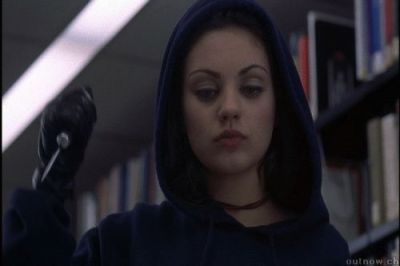| "Alright, everybody, here's a map to the funny bits." |
1) Why is it that everyone else seems to understand making effective John Carpenter movies these days better than, you know, John Carpenter? For just as Shaun of the Dead is the best George Romero movie not made by George Romero, this is the best Carpenter science-fiction film Carpenter never made.
2) ...although what Edgar Wright does that, let’s say, Neil Marshall doesn’t do in Doomsday (which also expressed much Carpenter love) is take elements and themes that Carpenter used in many of his 80‘s films and fused them with elements and themes that Wright himself is obsessed with to create something unique.
3) One of the genius things about the way the film is structured is how it’s something Carpenter has never done in any of his classic science fiction films--namely, it turns out to be an origin for a archtypical Carpenter hero, down to the rather heroically silly name.
4) If we accept The World’s End as the end of a loose trilogy that includes Shaun of The Dead and Hot Fuzz, I like how our two leads have effectively switched places psychologically in this film, with Nick Frost being the level-headed one and Simon Pegg being the screw up...which makes their role in the third act all the more surprising.
 |
| I would go through twelve pubs to fight by the side of Rosamund Pike...and I don't even drink. |
5) I love how Wright casts actors in roles I don’t expect them to be in. Paddy Constandine, in particular, is effectively cast against type. That being said, I almost didn’t register Pierce Brosnan (who must be here because Wright loves James Bond, as all good red-blooded men are) in his role until well into the movie itself.
6) Oh, Rosamund Pike...even looking sorta dowdy, you are a vision on loveliness...plus I figured your times in the Bond mines made you look kick-ass in the fight scenes.
7) What was the point of the giant sculpture thingie on the village green, other than to give us a wacko visual during the second act?
| Oh, show me the way to the next Carpenter film/Oh, don't ask why/Oh, don't ask why |
8) Thank God this is another light-hearted, action-inclusive comedy that was allowed to be rated R. I shudder to think how this movie, which relies so much on alcoholism, suicidal thoughts, mental illness and other darker themes, would play as a PG-13 film.
9) I appreciated the thought that was put into The Network, its motivations and its modus operandi. It gave the menace more of a nuance (something else that Carpenter seems to not be interested in in many of his films). Plus it allows some interpretation about whether Gary’s actions ultimately was for the benefit of humanity or not.
10) I do like how, even though Wright gives us the kind of dark, apocalyptic ending Carpenter was fond of, all of our characters got what they wanted...even if what they wanted wasn’t exactly in the pristine way they wanted it.
Overall...a great little picture that shows John Carpenter how he used to be able to do it, but with the kind of sensibility only Edgar Wright can pull off.
It was off to the Atlas for this, where I was the only patron save for three other folks, which was...kinda sad. Amongst the trailers were The Fifth Estate (Bernard Cumberbatch in a bleached blonde wig is the most shocking thing in this flick, apparently); Insidious 2 (another one of these ‘we showed these people the movie and look how scared they got’ trailer, which I think undermines the fact that it’s a sequel to a really effective, really good James Wan flick) and Getaway (I just don’t get Selena Gomez. I certainly don’t get Selena Gomez trying to act all gangsta and stuff). Oddly enough, the most fun I had prior to the show came from watching that risible Firstlook puff piece on The Crazy Ones, where Robin Williams improvises a sexy fast food song in front of Kelly Clarkson.







